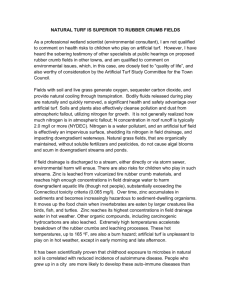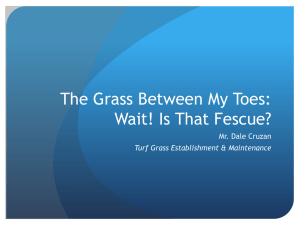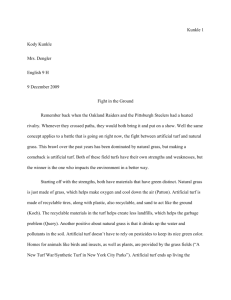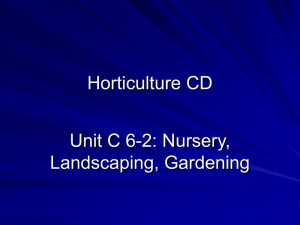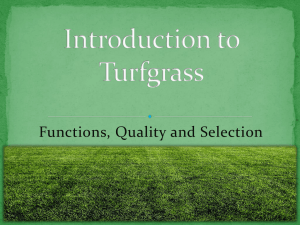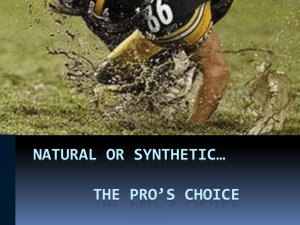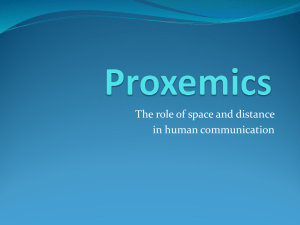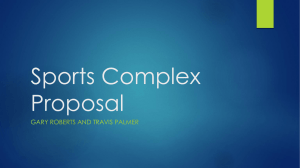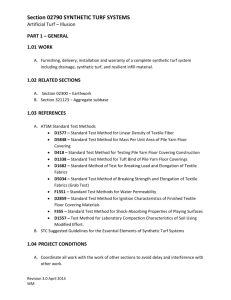Synthetic Field Turf
advertisement
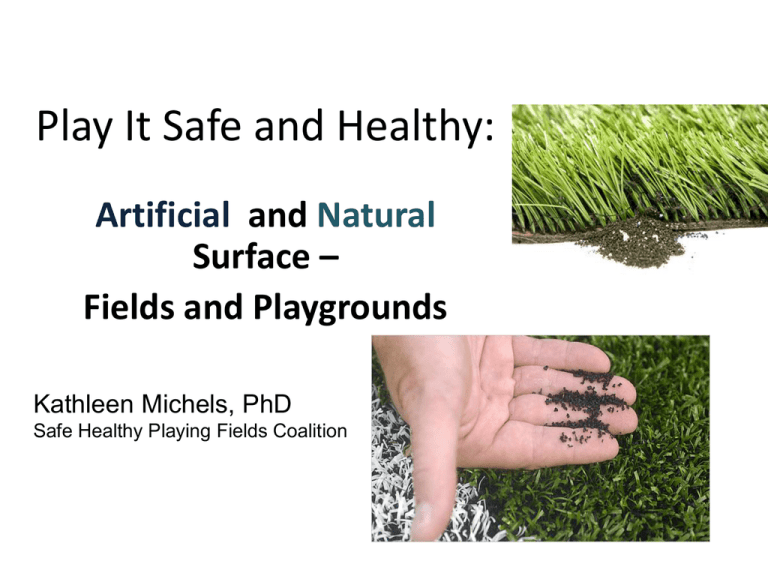
Play It Safe and Healthy: Artificial and Natural Surface – Fields and Playgrounds Kathleen Michels, PhD Safe Healthy Playing Fields Coalition A special thanks to: • Joel Forman, MD Associate Professor of Pediatrics and Community and Preventive Medicine Mount Sinai School of Medicine • Gary Ginsberg, Toxicologist, CT Dept Public Health • YOU – the Parents, coaches, players, physicians, scientists and others here and around the country supporting safe, healthy play areas for children. Disclosure I have no relevant financial relationship with the manufacturer of any commercial product and/or provider of commercial services discussed in this presentation. WE ALL WANT SAFE, HEALTHY, DURABLE FIELDS AND PLAYGROUNDS FOR OUR CHILDRENProblem: poorly installed, poorly or difficult to maintain grass fields (or concrete in urban areas). What are the options? •BETTER GRASS FIELDS • SYNTHETIC OPTIONS How can we make BOTH safer and healthier? Synthetic Turf History 1st Generation AstroTurf (flat carpet like) - 1960s Moses Brown - Prov, RI Houston Astrodome 2nd Generation Turf ( long fiber ‘blades’ and ‘infill’ tire crumb) 1990s Outdoor installation – took off about 2000 with most installed since 2004. Deterioration and replacement accelerating (note FieldTurf suing supplier over inferior plastic on installed fields over years- quality control ?- how can vendors ensure lead-free ?) Modern Synthetic Turf Design Plastic (nylon, PE) ‘blades’ in urethane backing Crumb rubber, coated sand, or other infill http://www.soccerworldsystems.com/Products.asp Asphalt, gravel with drainage Blair HS Field installation Plastic rug rolling out on deep layer of rocks Heat on Blair field before tire crumb infill addedair temp 86 deg F Artificial Turf, Natural Turf & Public Health: “REDUCING ENVIRONMENTAL CANCER RISK What We Can Do Now”- President’s Cancer Commission 2009. http://deainfo.nci.nih.gov/advisory/pcp/annualReports/pcp08-09rpt/PCP_Report_08-09_508.pdf • The incidence of some cancers, including some most common among children, is increasing for unexplained reasons. • ..current methods….fail to take into account harmful effects that may occur only at very low doses. Further, chemicals typically are administered when laboratory animals are in their adolescence, a methodology that fails to assess the impact of in utero, childhood, and lifelong exposures. In addition, agents are tested singly rather than in combination. Blade Composition and Coloring Nylon (older fields)- lead chromate – some very highthousands of older fields may have high lead levels – see recent EHP review Van Ulirsch G et al. 2010 Blades can be any color! Lighter colors are cooler! Polyethylene (Newer fields)lower lead or lead-free? Variable: No pre-consumer testing required – buyer is responsible for testing. Lead concern increases as synthetic fields age • Expert Review: review of all the available analyses (including the CPSC study often cited) the authors of this peer-reviewed 2010 article in the journal Environmental Health Perspectives conclude that: synthetic turf can deteriorate to form dust containing lead at levels that may pose a risk to children and all current fields should be tested for lead content and then routinely tested for surface lead if lead over limit for children’s toys is found in the blades. Evaluating and Regulating Lead in Synthetic Turf. Environmental Health Perspectives (EHP) 118(10): Oct 2010 Van Ulirsch G, Gleason K, Gerstenberger S, Moffett DB, Pulliam G, et al. http://ehp03.niehs.nih.gov/article/fetchArticle.action;jsessionid=329B79696CEF833977FD20963FAB6 3BF?articleURI=info%3Adoi%2F10.1289%2Fehp.1002239 Early Field Temperature Data University of Missouri Research - Brad Fresenburg. University of Missouri Ambient temp - 98 degrees Artificial Turf Surface Temperature - 173 Natural Grass Temperature - 105 Head Level Air Temperature - 138 BYU Field study 2002 : Williams and Pulley, Brigham Young University One of the trainers received blisters through his training shoes (which has also been reported by local coaches and players) Artificial Turf Avg. 117, high of 157 Natural Grass Avg. 78, high of 88.5 HEAT The Industry’s solution NPR in NYC- 86 deg F day- 160 deg F on the fieldchildren dripping in sweat and wilting. • Rick Doyle, president of the Synthetic Turf Council: "I don't think anyone in our industry would suggest it's a good idea to play on a surface that's that hot.”... “Just as coaches have to reschedule games due to rain when they play on grass fields, so too they need to reschedule or consider an alternative surface to play on when it's hot and sunny.” http://www.npr.org/templates/story/story.php?storyId=93364750 Samples of Coach’s Laments on Artificial Turf • Lynette Scaffidi- Coach, Mom2 elite middle school players, player – Montgomery County, MD (see attached notes) • Chris Hummer- Soccer Coach, Coordinator, journalist, player, Fairfax, VA (see attached notes) • Lacrosse Coach , St.Mary’s College, MD (see attached notes) Heat Solutions for AT • Develop guidelines using American Academy of Pediatrics Heat Stress guidance to decide when to take/keep kids off the field • USE LIGHTER COLORS OF THE PLASTIC! INFILL OPTIONS • Pulverized used TIRES- (contain known and unknown neurotoxins, carcinogens) • Virgin Rubber (no associated carbon black or vulcanization compounds but latex may be allergenic ) • Rubber Coated Sand • Thermoplastic Elastomer (TPE) Infill (highly recyclable) • Cork and Coconut Husk (biodegradable) Infill option: Pulverized Used Tires (20-40,000 tires- 120-250 tons per field) RUBBER- Natural latex or Synthetic • Styrene and Butadiene (30% or more) Carbon Black (30% or more)- (10-100 nm ultrafine nanoparticles- see note) OTHER (For vulcanization, heat, wear, strength) *Recipe variable with different tire products* • • • • • lead, copper, chromium, zinc, cadmium, arsenic, others Phthalates, phenols Volatile aromatic compounds (VOCs) Poly aromatic hydrocarbons (PAHs) Other–WILL NEVER KNOW ALL. SECRET, VARIABLE Artificial Turf, Natural Turf & Public Health: “REDUCING ENVIRONMENTAL CANCER RISK What We Can Do Now”- President’s Cancer Commission 2009. http://deainfo.nci.nih.gov/advisory/pcp/annualReports/pcp08-09rpt/PCP_Report_08-09_508.pdf • The incidence of some cancers, including some most common among children, is increasing for unexplained reasons. • ..current methods….fail to take into account harmful effects that may occur only at very low doses. Further, chemicals typically are administered when laboratory animals are in their adolescence, a methodology that fails to assess the impact of in utero, childhood, and lifelong exposures. In addition, agents are tested singly rather than in combination. REDUCING ENVIRONMENTAL CANCER RISK What We Can Do Now”- President’s Cancer Commission Regulation of Environmental Contaminants: • The prevailing regulatory approach in the United States is reactionary rather than precautionary. That is, instead of taking preventive action when uncertainty exists about the potential harm a chemical or other environmental contaminant may cause, a hazard must be incontrovertibly demonstrated before action to ameliorate it is initiated. Moreover, instead of requiring industry or other proponents of specific chemicals, devices, or activities to prove their safety, the public bears the burden of proving that a given environmental exposure is harmful. Only a few hundred of the more than 80,000 chemicals in use in the United States have been tested for safety. REDUCING ENVIRONMENTAL CANCER RISK What We Can Do Now”- President’s Cancer Commission U.S. regulation of environmental contaminants is rendered ineffective by five major problems: (1)inadequate funding and insufficient staffing, (2)fragmented and overlapping authorities coupled with uneven and decentralized enforcement, (3)excessive regulatory complexity, (4)weak laws and regulations, and (5)undue industry influence. Too often, these factors, either singly or in combination, result in agency dysfunction and a lack of will to identify and remove hazards. Potential Adverse Health Effects Exposures to Toxins: zinc, lead, copper, chromium, cadmium, PAHs, phthalates, phenols, carbon black Routes of exposure and concern: Breathing Contact – Skin or Mucous Membrane irritation and absorption Ingestion - Hand to Mouth Excessive Heat Burns Dehydration Injuries? Increased ‘turf burns’- Infection Risk ? Nanoparticles in Tires 1) Carbon black is a large component of tires and consists of the smallest nanoparticles. 2) Toxic Potential of Materials at the Nanolevel, Andre et al. • Engineered nanomaterials (NM) are already being used in tires, • “It is possible that the release of nanotubes from an intended commercial use product such as car tires could become airborne.” WHAT IS GOOD FOR TIRES IS BAD FOR CHILDREN • What is good for tires is also bad for the health of our streams and rivers- Zinc in particular is toxic to aquatic organisms. • Alternative infills or (organically) maintained natural grass fields are the solution. Stated Benefits of Synthetic Turf? Decreased maintenance requirement? All weather play (but need guidelines for excessive heat) Greater availability No need for pesticides and fertilizers (but contains toxins) Resource conservation (fossil fuel and water- but needs grooming, replacement, cleaning, cooling) Lower long term costs (Not if you factor in replacement and disposal costs) Aesthetics (always the same shiny green- but that needs to be balanced against cooling) A use for used tires (but merely delays the trip to the landfill of 20,000 to 40,000 tires from another state or even another country) Synthetic turf Balancing Act Field Use (but heat?) Water Conservation (but cleaning and heat reduction)? Use for Used Tires (but then they go to local landfill ) Less maintenance? Benefits Local Heat Effects and health risk Toxic Exposures on Fields Toxins Disbursed from Field Environmental Heat Effects High Cost Ecosystem Impact (runoff) Unsustainable- dispose repeatedly in landfills) Risks Unique Vulnerabilities of Children Children consume more food, drink more water, and breathe faster than adults 7 times more water per Kg per day Children have unique behaviors, diets, and are closer to the ground hand to mouth behaviors Young children have unique windows of heightened biological vulnerability thalidomide, DES, fetal alcohol syndrome, Minamata, lead Children develop roots of adult health and disease ( see effects years later) cancer, cardiovascular disease, diabetes, immune disorders Early Studies on Toxin Release Rutgers - 2006 EHHI (CT - 8/07) NYC samples Demonstrated volatilization of phenols and PAHs at 118 PAHs leached from degrees F synthetic turf rubber pellets at levels 3x what Zinc, Selenium, Lead, is allowed in Cadmium were found in distilled contaminated soil water leachate after 7 weeks Used solvents and nitric Higher amounts when acidified acid water used The lab conditions used may not have accurately reflected real world conditions- but intent to simulate digestion. Injuries 5-year Prospective Comparison of Injuries on Natural Grass and FieldTurf. – (mostly new artificial fields compared with older, probably compacted natural fields ) (Meyers et al. 2004; 32; 1626Am. J. Sports Med.) Injury patterns differed: Higher incidences of non-contact injuries, surface/epidermal injuries, muscle-related trauma, and injuries during higher temperatures were reported on FieldTurf. Higher incidences of head and neural trauma, and ligament injuries were reported on natural grass. Recent studies show higher rates of ACL injuries on artificial turf. EPA Scoping Study 2009 • Key findings: • Substantial variability in: • Materials used in the infill • Concentration of contaminants even at a single site • Increased PM10 and metals at playground site with high activity • Above background levels • Below NAAQS levels • EPA Conclusion: On average, concentrations of components monitored in this study were below levels of concern • EPA Disclaimer: • Limited nature of this study • limited number of components monitored, samples sites, and samples taken at each site • Wide diversity of tire crumb material • EPA Conclusion: • More comprehensive conclusions not possible without the consideration of additional data. CT DEP Leachate and Storm Water Study 2010 (one of a group of studies) • 80% of leachate acutely toxic to aquatic life for Cu and Zn and 20% for Cd, Mn, Pb • Runoff samples from rain events: • Zn major metal in runoff • 3 of 8 runoff sampling events were acutely toxic to aquatic life • Conclusion: • Potential risk to surface waters and aquatic organisms • From whole effluent • From Zinc NY State DEC 2009 • Zinc and a few other compounds had the potential to be released above groundwater standards or guidance values • VOCs and SVOCs not significantly elevated in air • PM data deemed partly unreliable but did find elevated PM levels during play and downwind • Surface temps were MUCH Higher (~ 35 - 45 degrees) • Approximately 70% of the measurement dates at both fields warranted some type of guidance for exercising children and adolescents based on American Academy of Pediatrics (AAP) guidelines (even though ambient temps were only in the low 80s) • Limitations: • Mild ambient temperatures only studied (low 80's) • No personal monitoring during play! California OEHHA Study Fall 2010 Particulate matter 2.5 and 10 - not increased (ULTRA FINES NOT MONITORED, NO PERSONAL MONITORING). VOCs - A few detected • Levels higher than natural turf comparisons (but levels were nonetheless deemed below health based screening levels). Abrasions: found 2 - 3 fold higher for college soccer players in study • The CDC cluster studies identified the locker room as a key source of MRSA (towels, whirlpool baths, etc.) Thus more abrasions could be significant - needs more study. The lower bacterial counts on the field may not be germane- SOIL HAS BENEFICIAL as well as pathogenic organisms- hence its detoxification of contaminants (see oxygen study) California OEHHA Study Fall 2010 -Limitations Limitations: • Particulate monitoring height 4ft -above child breathing zone. No personal monitoring or monitoring for nanoparticles Variability: • of infill source material, age, type of processing, ambient temperatures- inability to know the full composition of tire crumb infill. • Outdoor vs. Indoor • Abrasion rates may vary- by sport, age, field, temp • Bacterial presence on field may vary by season and temperature. • Testing not done at high heat but Surface temps were still clearly much hotter than grass —16-39 degrees higher at mild air temperatures. Other Concerns Not Well Studied • Black Carbon and Carbon Nanotubes (see notes) • Carbon black is 30 % or more of tire: Added to tires to give strength and color • Conducts heat away from tread and increases tire life • Exposure?: Makes kids’ skin black after playing - airborne nanoparticles? (see notes) • Health concerns of carbon black and engineered carbon nanotubes(from other settings): • Cancer (mesothelioma?) • Elevated BP in adults • Neurodevelopmental impact Costs Not Considered for synthetic turf “Brooming”, vacuuming or raking- (increases for heavily used fields) Grooming to loosen infill and keep blades standign upright (more often for more heavily used fields) Repairing loose seams or burns REPLACEMENT and disposal costs Potential environmental cleanup costs Cost variance by type of field (soccer vs baseball) Alternatives Alternative Infill: • Rubber Coated Sand • Thermoplastic Elastomer (TPE) Infill • New Rubber - Ethylene Propylene Diene Monomer rubber (EPDM) • Cork and Coconut Husk Alternative surfaces and groundwork • Natural Grass- native soil, engineered soil, sand based, sand capped etc. – Problems: Synthetic Fertilizers and Pesticides. Solutions- use IPM and organic maintenance Alternative Natural Grass Systems Natural Grass Systems evolving- Features: Selecting the right grass (prevailing weather) Drainage System Perforated pipe system Pea Gravel or Sand Root Zone Mix Grass Seed or Sod Fewer or no synthetic inputs: IPM and organic maintenance Brad Fresenburg. University of Missouri Options- Better Grass Fields Dramatic rise in research on grass varieties for fields in the 1990s(USDA, Universities) Improved: wear tolerance, shoot density and root depth, strength of recovery, shade and heat tolerance Engineered soils, drainage systems equivalent to the rock base for synthetic turf- plus soil filters contaminants better Stormwater recapture and reuse for irrigation – (required in Fla, SW. St. Mary’s College uses). Fewer synthetic inputs: organic and IPM pest control – focus on improving soil Summary-Playing Field Choices Compelling need for increased sports field access but… Need to carefully evaluate how much Synthetic Turf really increases access (Heat Issues) over well constructed natural turf. New techniques for better designed and maintained natural fields both increase access and get around health problems In shade or indoors – Synthetic needed but check out alternatives to tire crumb infill with fewer known and unknown health issues Summary Issues -synthetic turf Plastic turf heat issues very well demonstrated- lighter color plastic may help but not full answer. Chemical and toxin exposure from recycled tire infill are not adequately investigated and can never fully be known New issues like Black Carbon and engineered nanoparticles are troubling (what else don’t we know that we need to know?) Cost calculations need to include replacement and disposal of artificial turf Increased abrasions may lead to more infection Alternative infill may eliminate some concerns as a compromise (shade, indoors) and be more precautionary Tips for safer use of plastic turf fields: Do not use the turf fields on extremely hot days. Be sure to clean and monitor any “turf burns” obtained while playing. Attempt to remove all pellets from shoes and clothes prior to leaving the fields. At home, shake out your children’s equipment and clothes in the garage or over the garbage. Have your child shower and wash thoroughly after playing on the field. Natural Turf see notes • For more information about better natural turf please visit the links below (and see attached notes): • Branford, CT where Parks Director Alex Palluzzi maintains dozens of durable and long lasting grass athletic fields organically: <http://www.beyondpesticides.org/lawn/activist/BranfordCT policy.pdf> and see the recent follow up: <http://www.beyondpesticides.org/dailynewsblog/?p=1099> Fields are used (and rented) from March to November 7 days per week (all day on Saturdays and Sundays) for multiple sports. For more information contact apalluzzi@branford-ct.gov, phone: 203-488-8304. • Kevin Mercer's St. Mary's College, Maryland (ksmercer@smcm.edu, phone:(240)-895-3235 )- responsible for: ► 25 acres of groomed lawn ► ► 12 acres of sports fields ► 100 acres of common lawns <http://www.smcm.edu/rivergazette/archives/decjan09/ DecJanSpread09new.pdf > low cost, durable, low chemical input, organic Turfgrass Research- durability, beauty, environmental footprint • Kevin Morris -USDA , Executive Director, National Turfgrass Evaluation Program (Phone 301-504-5125 Kevin.Morris@ARS.USDA.GOV) Research on new grasses and engineering better soils for athletic fields http://www.ars.usda.gov/is/AR/archive/nov10/gardens1110.htm> • Harvard's wildly successful durable organic turfgrass : The Grass Is Greener at Harvard: organic care withstands the pounding of thousands of feet daily "<http://www.beyondpesticides.org/dailynewsblog/?p=2530> <http://www.nytimes.com/2009/09/24/garden/24garden.html?emc=eta1> Turfgrass research continued • Dr Brad Fresenburg (U. Missouri): field and Turfgrass expert – conducting ongoing tests with both artificial and natural turf : "Synthetic Turf Playing Fields Present Unique Dangers" <http://cafnr.missouri.edu/research/turfgrass.php> . – Turfgrass Debate video featuring Jerad Minnick and Brad Fresenburg: <mms://etcs.ext.missouri.edu/turfgrassdebate.wmv> – Suggests financing options for maintenance – < http://cafnr.missouri.edu/research/turfgrass-costs.php > – as recently also advocated by Soccer Wire's Chris Hummer < http://www.potomacsoccerwire.com/news/5322/12633 > Thank You Questions?
